This article was co-authored by Miguel Cunha, DPM and by wikiHow staff writer, Megaera Lorenz, PhD. Dr. Miguel Cunha is the founder of Gotham Footcare and is a podiatrist based in Manhattan, New York. Dr. Cunha is a foot and ankle surgeon with experience treating a wide array of foot and ankle conditions from minor problems to complex reconstructive foot and ankle surgery. Dr. Cunha received his DPM from the Temple University School of Podiatric Medicine and completed his residency as the Chief Resident at the Washington Hospital Center and Georgetown University where he specialized in lower extremity trauma, diabetic limb salvage, and reconstructive surgery of the foot and ankle. Dr. Cunha is a member of the American Podiatric Medical Association, the New York Podiatric Medical Association, the American College of Foot and Ankle Surgeons, and is board certified in Podiatric Medicine.
There are 14 references cited in this article, which can be found at the bottom of the page.
wikiHow marks an article as reader-approved once it receives enough positive feedback. In this case, several readers have written to tell us that this article was helpful to them, earning it our reader-approved status.
This article has been viewed 414,147 times.
Athlete’s foot is a fungal infection that causes a red, scaly rash on your feet, usually starting between the toes. While it can be uncomfortable and embarrassing, it’s usually not serious—and most of the time, you can quickly clear it up with an over-the-counter ointment. Keep reading to learn how to prevent athlete’s foot, and what to do if it’s not going away.
Steps
Expert Q&A
-
QuestionWill Lysol kill athlete's foot in shoes?
 Miguel Cunha, DPMDr. Miguel Cunha is the founder of Gotham Footcare and is a podiatrist based in Manhattan, New York. Dr. Cunha is a foot and ankle surgeon with experience treating a wide array of foot and ankle conditions from minor problems to complex reconstructive foot and ankle surgery. Dr. Cunha received his DPM from the Temple University School of Podiatric Medicine and completed his residency as the Chief Resident at the Washington Hospital Center and Georgetown University where he specialized in lower extremity trauma, diabetic limb salvage, and reconstructive surgery of the foot and ankle. Dr. Cunha is a member of the American Podiatric Medical Association, the New York Podiatric Medical Association, the American College of Foot and Ankle Surgeons, and is board certified in Podiatric Medicine.
Miguel Cunha, DPMDr. Miguel Cunha is the founder of Gotham Footcare and is a podiatrist based in Manhattan, New York. Dr. Cunha is a foot and ankle surgeon with experience treating a wide array of foot and ankle conditions from minor problems to complex reconstructive foot and ankle surgery. Dr. Cunha received his DPM from the Temple University School of Podiatric Medicine and completed his residency as the Chief Resident at the Washington Hospital Center and Georgetown University where he specialized in lower extremity trauma, diabetic limb salvage, and reconstructive surgery of the foot and ankle. Dr. Cunha is a member of the American Podiatric Medical Association, the New York Podiatric Medical Association, the American College of Foot and Ankle Surgeons, and is board certified in Podiatric Medicine.
Board Certified Podiatrist Yes. Just spray the Lysol into the shoes to kill the fungus. If you think you have athlete's foot, go ahead and spray your shoes.
Yes. Just spray the Lysol into the shoes to kill the fungus. If you think you have athlete's foot, go ahead and spray your shoes. -
QuestionWhat's the best way to effectively treat athlete's foot?
 Miguel Cunha, DPMDr. Miguel Cunha is the founder of Gotham Footcare and is a podiatrist based in Manhattan, New York. Dr. Cunha is a foot and ankle surgeon with experience treating a wide array of foot and ankle conditions from minor problems to complex reconstructive foot and ankle surgery. Dr. Cunha received his DPM from the Temple University School of Podiatric Medicine and completed his residency as the Chief Resident at the Washington Hospital Center and Georgetown University where he specialized in lower extremity trauma, diabetic limb salvage, and reconstructive surgery of the foot and ankle. Dr. Cunha is a member of the American Podiatric Medical Association, the New York Podiatric Medical Association, the American College of Foot and Ankle Surgeons, and is board certified in Podiatric Medicine.
Miguel Cunha, DPMDr. Miguel Cunha is the founder of Gotham Footcare and is a podiatrist based in Manhattan, New York. Dr. Cunha is a foot and ankle surgeon with experience treating a wide array of foot and ankle conditions from minor problems to complex reconstructive foot and ankle surgery. Dr. Cunha received his DPM from the Temple University School of Podiatric Medicine and completed his residency as the Chief Resident at the Washington Hospital Center and Georgetown University where he specialized in lower extremity trauma, diabetic limb salvage, and reconstructive surgery of the foot and ankle. Dr. Cunha is a member of the American Podiatric Medical Association, the New York Podiatric Medical Association, the American College of Foot and Ankle Surgeons, and is board certified in Podiatric Medicine.
Board Certified Podiatrist Use a topical antifungal treatment twice a day for 2 weeks. If the fungus is still present after that, see your doctor—they may prescribe a stronger antifungal cream, or even an oral antifungal medication.
Use a topical antifungal treatment twice a day for 2 weeks. If the fungus is still present after that, see your doctor—they may prescribe a stronger antifungal cream, or even an oral antifungal medication.
Warnings
- The fungus that causes athlete’s foot can spread to other parts of your body. This fungus is also known as jock itch (when it affects your groin area) or ringworm. Always wash your hands carefully after touching your rash, and avoid scratching or rubbing it.[29]⧼thumbs_response⧽
- If your doctor prescribes an oral medication for athlete’s foot, let them know if you have any other medical conditions or are currently taking other medications. This will help them determine whether you can take antifungals safely.[30]⧼thumbs_response⧽
References
- ↑ https://www.health.harvard.edu/staying-healthy/athletes-foot-causes-prevention-and-treatment
- ↑ Miguel Cunha, DPM. Board Certified Podiatrist. Expert Interview. 22 April 2020.
- ↑ Miguel Cunha, DPM. Board Certified Podiatrist. Expert Interview. 22 April 2020.
- ↑ https://www.health.harvard.edu/staying-healthy/athletes-foot-causes-prevention-and-treatment
- ↑ https://www.drugs.com/cons/podactin-topical.html
- ↑ https://www.ncbi.nlm.nih.gov/pmc/articles/PMC4352499/#B8
- ↑ https://www.ipfh.org/foot-care-essentials/how-to-practice-good-foot-hygiene
- ↑ https://www.uofmhealth.org/health-library/d03202a1
- ↑ https://www.aad.org/public/diseases/a-z/athletes-foot-prevent
- ↑ https://www.nhs.uk/conditions/athletes-foot/
- ↑ https://www.health.harvard.edu/staying-healthy/athletes-foot-causes-prevention-and-treatment
- ↑ https://www.mayoclinic.org/diseases-conditions/athletes-foot/diagnosis-treatment/drc-20353847
- ↑ https://www.health.harvard.edu/staying-healthy/athletes-foot-causes-prevention-and-treatment
- ↑ https://www.health.harvard.edu/staying-healthy/athletes-foot-causes-prevention-and-treatment
- ↑ https://www.nhs.uk/conditions/athletes-foot/
- ↑ https://www.mayoclinic.org/diseases-conditions/athletes-foot/diagnosis-treatment/drc-20353847
- ↑ https://www.nhs.uk/conditions/athletes-foot/
- ↑ https://www.mayoclinic.org/diseases-conditions/athletes-foot/diagnosis-treatment/drc-20353847
- ↑ Miguel Cunha, DPM. Board Certified Podiatrist. Expert Interview. 22 April 2020.
- ↑ https://www.mayoclinic.org/diseases-conditions/athletes-foot/symptoms-causes/syc-20353841
- ↑ https://www.aad.org/public/diseases/a-z/athletes-foot-prevent
- ↑ https://www.aad.org/public/diseases/a-z/athletes-foot-prevent
- ↑ https://www.aad.org/public/diseases/a-z/athletes-foot-prevent
- ↑ https://my.clevelandclinic.org/health/articles/4560-athletes-foot-jock-itch-and-ringworm-of-the-scalp
- ↑ https://my.clevelandclinic.org/health/articles/4560-athletes-foot-jock-itch-and-ringworm-of-the-scalp
- ↑ https://extension.purdue.edu/elkhart/article/35678
- ↑ https://www.ncbi.nlm.nih.gov/books/NBK279548/
- ↑ https://www.aafp.org/afp/2014/1115/p702.html
- ↑ https://my.clevelandclinic.org/health/articles/4560-athletes-foot-jock-itch-and-ringworm-of-the-scalp
- ↑ https://www.ncbi.nlm.nih.gov/books/NBK279548/
About This Article
If you have athlete’s foot, treat the affected area with an anti-fungal cream or spray every day for 3-6 weeks, depending on the severity of the infection. Continue applying the treatment even after the visible symptoms are gone to ensure you get rid of all of the fungus. In the meantime, you can help relieve the symptoms by sprinkling cornstarch on your feet whenever they’re damp. This will help absorb any moisture while suffocating the fungus, and you can continue the practice after you’re healed to keep your athlete’s foot from returning. Read on to learn how wearing sandals can help treat and prevent athlete’s foot!
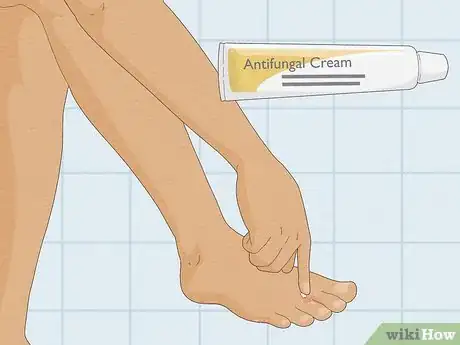







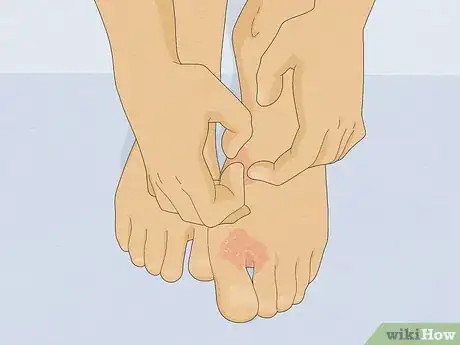
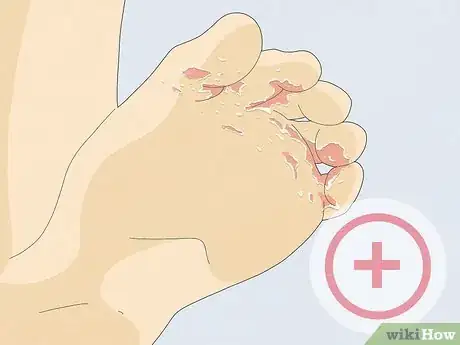

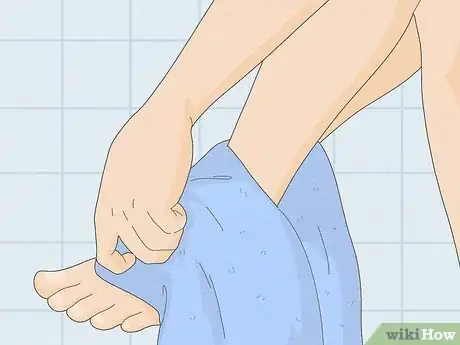





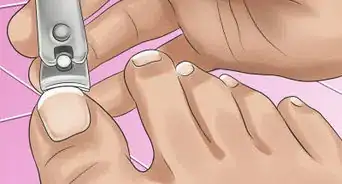


























































Medical Disclaimer
The content of this article is not intended to be a substitute for professional medical advice, examination, diagnosis, or treatment. You should always contact your doctor or other qualified healthcare professional before starting, changing, or stopping any kind of health treatment.
Read More...